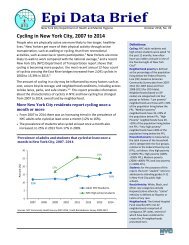2013-dot-sustainable-streets-lowres
2013-dot-sustainable-streets-lowres
2013-dot-sustainable-streets-lowres
You also want an ePaper? Increase the reach of your titles
YUMPU automatically turns print PDFs into web optimized ePapers that Google loves.
MOBILITYNYCDOT has found walking rates inNew York City are on the rise—10% ofNew York City residents walk to workWALKINGStreets that welcome people and encourage walking are a crucialelement of a <strong>sustainable</strong> city. Streets made for people are inviting,safe, and easy to navigate. NYCDOT has used treatments outlined inthe Safety and World Class Streets sections of this book, includingtraffic calming, intersection engineering, signal timing, publicplazas and street seating as part of a comprehensive effort to make<strong>streets</strong> inviting and attractive for walking. Additionally, NYC hasdeveloped a number of key projects designed to foster easier walkingconnections, and to provide information to New Yorkers and visitorsalike that many trips within the City can be easily and perhaps mostconveniently and quickly accomplished on foot.NYCDOT has found walking rates in New York City are on the rise.10% of New York City residents walk to work (2005–2007), someof the highest rates in the country (The Green Dividend, NYCDOT,April 2010). The city’s pedestrian volume index (see box, next page)tracks walking rates at locations throughout the city and tracks a12.9% increase in walking since 2007. The growth in public transitusage highlighted earlier in this chapter also points to more walkingin the city—nearly all subway or bus riders start or end their tripsby walking.More walking is walking is good for health, mobility and theeconomic bottom line. Research in the United Kingdom has found adirect relationship between the way in which people travel aroundcity centers and the amount of money they spend. The weeklyexpenditure of consumers who walk was 42% higher than thosewho drive. (Economic Value of Livability, Todd Littman, VictoriaTransport Policy Institute, 2010). Real estate in areas with aboveaverage levels of walkability command a premium between $4,000and $34,000 over houses in areas with average levels of walkability.(Walking the Walk: How Walkability Raises Home Values in US Cities,CEOs for Cities, 2009).NYCDOT research also confirms that improvements in the walkingand public space environment are good for business. The expandedpublic and pedestrian space near Union Square resulted in 49%fewer commercial vacancies (compared to 5% more borough–wide).Pedestrian plazas and walkability improvements in Pearl Street inBrooklyn resulted in a 172% increase in retail sales at locally–basedbusinesses, compared to 18% borough–wide.With these numbers in mind, NYCDOT has created innovativeprojects to encourage walking and build a safer, easier to navigatewalking network.Sustainable Streets: <strong>2013</strong> and Beyond99



